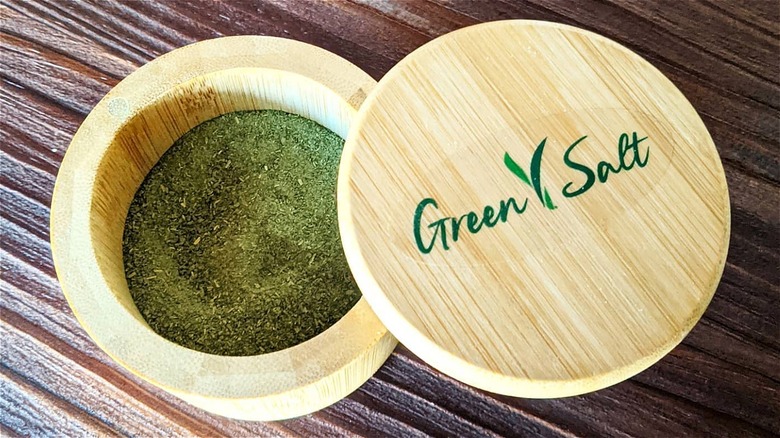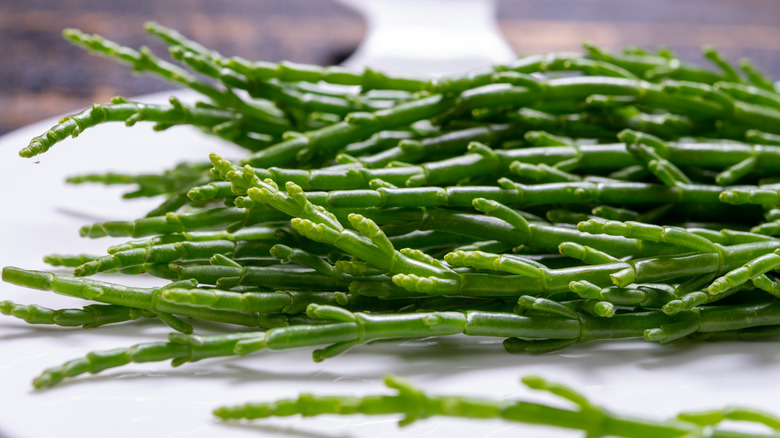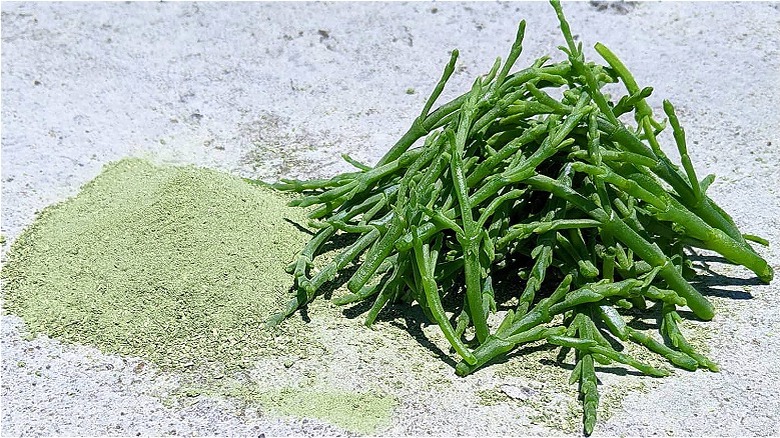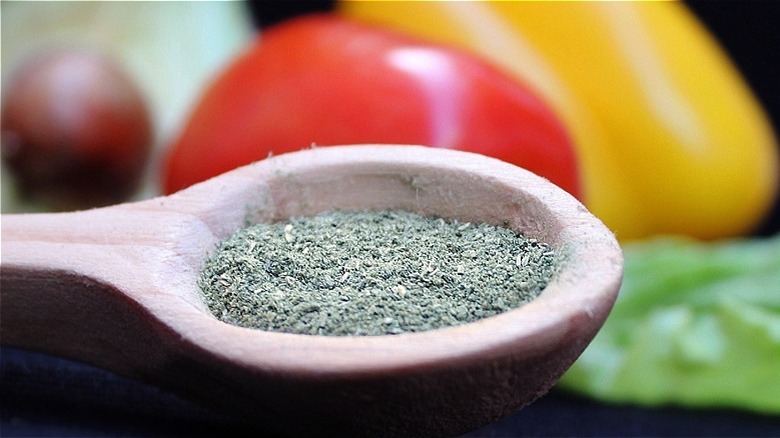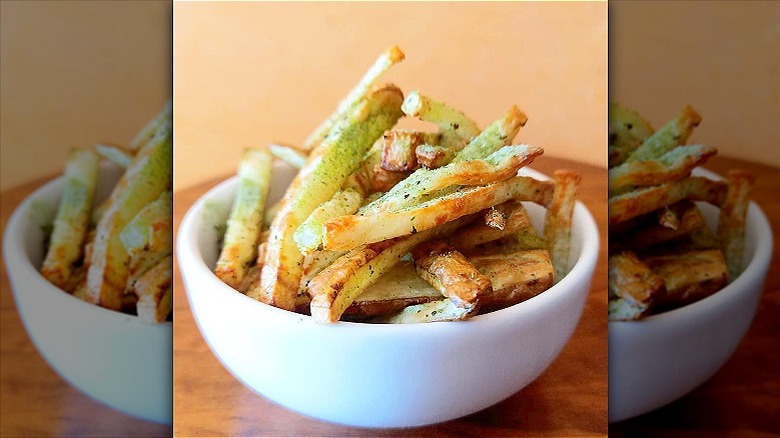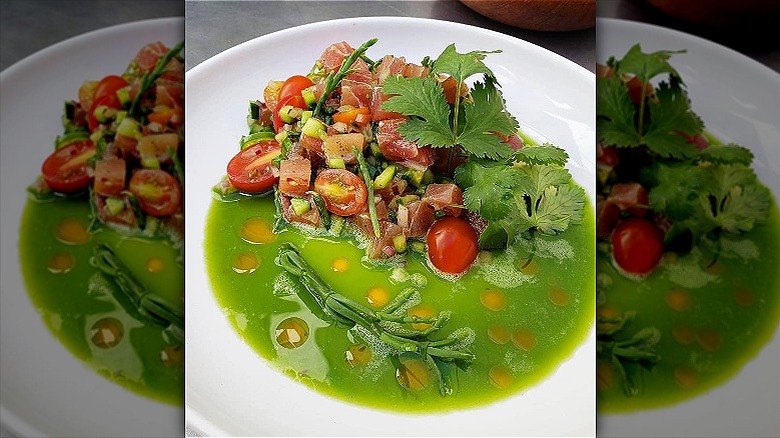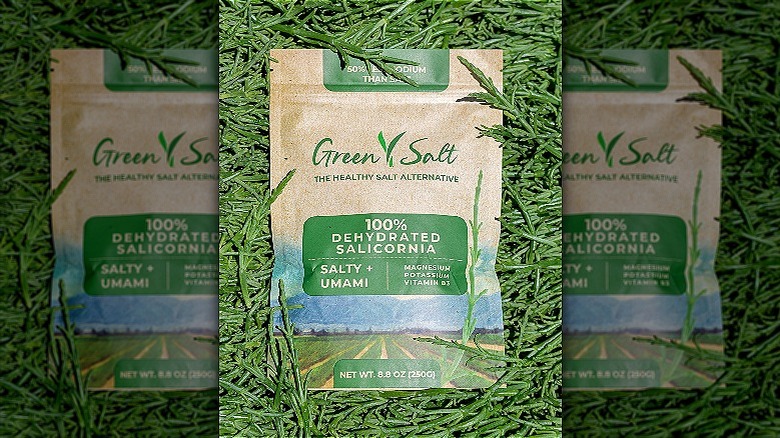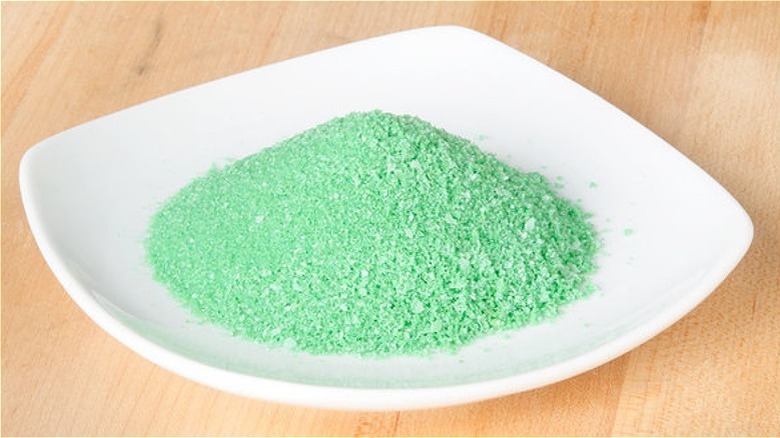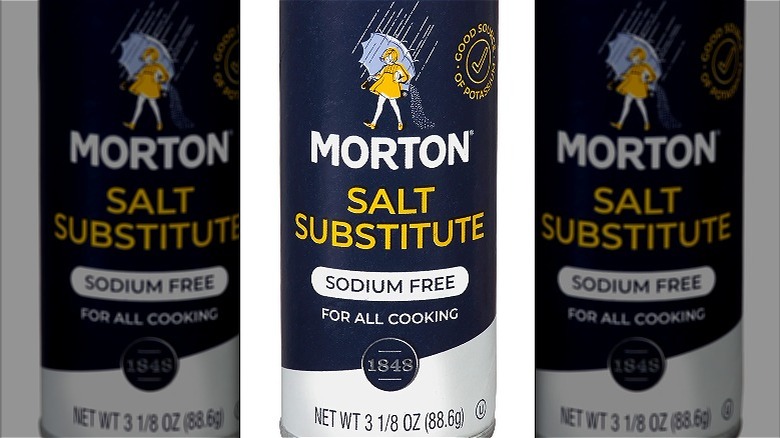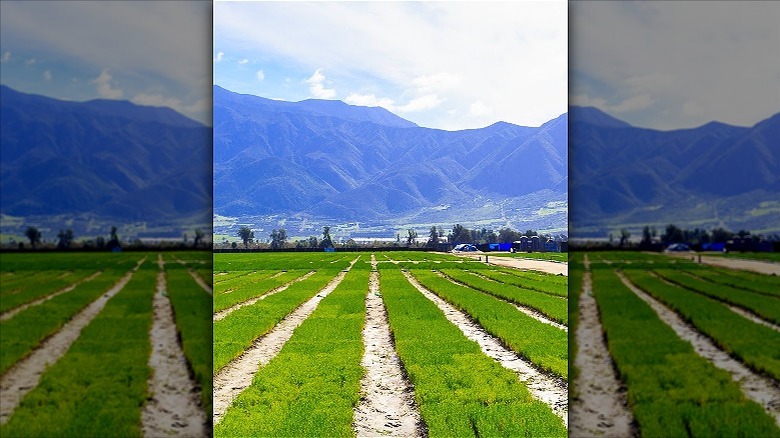What Is Green Salt, And Is It Even Salt?
We may receive a commission on purchases made from links.
Salt has been an invaluable aspect of human civilization for over 6,000 years. Its necessity in preserving and seasoning food, place in religious ceremonies, and medicinal applications made it a commodity that has shaped the evolution of modern-day societies. From a culinary perspective, salt plays numerous integral roles beyond flavor and preservation. It helps to improve the texture of foods, serves as an emulsifier, and influences the chemical reactions of leaveners in baking.
From a health vantage point, while salt intake above 2,300 milligrams per day, or 1 teaspoon of table salt, is contraindicated by the Food and Drug Administration due to its impact on blood pressure and heart health, eliminating salt from your diet is also considered dangerous. Salt is necessary for several bodily functions, from balancing fluids and nutrient absorption to healthy neurological and muscular processes.
The key has long been to determine a healthy balance of sodium intake, which has involved the continual search for salt replacements or supplements. Some have proven more or less effective in mimicking salt, while others have left much to the imagination. Enter green salt — the latest invention that promises to revolutionize our health and culinary game. But what is it, and is it even salt? Let's take a look at this fascinating new condiment and how it may be the answer to our culinary prayers.
What is green salt?
First off, green salt isn't salt at all. Typically sea salt and table salt are obtained from evaporating sea water or, in the case of rock salt, are harvested from salt mines before getting refined further. Green salt gets manufactured from desiccated and pulverized Salicornia, a type of sea bean or sea asparagus, a member of the salt-friendly family of plants known as halophytes, which also includes quinoa and amaranth.
Salicornia usually grows in salt-water estuaries and marshes, where it can grow year-round. While Salicornia is a lesser-known edible plant in the U.S., it has been consumed for centuries across Asia, particularly in Korea, where it is often pickled or stir-fried. This plant-based salt alternative was the brain-child of the Noriega family, who became the first commercial growers of Salicornia globally about 20 years ago. Their farm, in Baja, California, takes pure dehydrated Salicornia and grinds it without incorporating preservatives or additives.
The salt-like product is FDA-registered and USDA-approved. They also maintain strict quality control measures, including filtering their seawater and assessing their soil, water, and products for any traces of heavy metals or microorganisms. Green salt gets its name from its natural green color, typical of the plant when harvested in the summer. As it ages into the winter, the plant becomes reddish in hue and retains more salt in its horns.
Is green salt good for you?
Not only has Salicornia been consumed for centuries by Koreans who believed it to have medicinal value, but during the 17th century, sailors readily ate it, thinking it would help fortify their immune systems. New research has shown this intuitive deduction to agree with scientific research into the myriad health benefits of this plant. Not only does it contain 50% less sodium than salt, but it is also replete with significant quantities of fiber, 20%, and protein, 11%, neither of which can get found in salt.
It is also rich in several vitamins and minerals, including Vitamin B3, Vitamin C, Magnesium, Calcium, Iodine, Potassium, and Chlorophyll. Experts have noted that despite its Potassium content, its levels are well below what is accepted as safe for those with kidney disease to ingest, according to Health Digest. Additional studies have linked eating Salicornia with antioxidant, anti-inflammatory, antidiabetic, and anticancer properties, making it a superfood with great nutritional potential.
How does green salt compare with regular salt?
It bears noting that while green salt is not salt per se, it does contain sodium as a by-product of how Salicornia grows in saltwater. As such, it has approximately 50% less sodium than salt, roughly translating to 280 milligrams of sodium per ½ teaspoon of green salt versus a hefty 1,150 milligrams of sodium per ½ teaspoon of table salt. That's a sizable difference for anyone monitoring sodium intake. And while salt contains no fiber or protein, green salt has both.
Additionally, table salt is often fortified with iodine to help mitigate iodine deficiencies. Recommended daily allowance for iodine intake for adults is about 150 micrograms per day. Table salt contains an average of 45 micrograms of iodine per gram of salt. Green salt is not fortified but contains naturally occurring iodine at 0.27 micrograms per 1.5-gram serving, making it a great supplement to a well-balanced diet.
And in research conducted in 2015, scientists administered table salt and green salt in quantities with equivalent sodium levels to rats. While the regular salt negatively impacted blood pressure measurements, the salt derived from Salicornia did not. These rats maintained healthy blood pressure with zero influence on hypertension or oxidative stress. This factor may prove a game changer for those with hypertension, although it may still be wise to use even green salt in moderation to obtain its maximum health benefits.
What does green salt taste like?
While green salt has an inherent salinity, perhaps its most aggressive flavor profile is its umami-forward savoriness. Its flavor may get best described as a combination of the dry seaweed used for sushi called Nori and the slightly salty seafood aftertaste of Bonito flakes, which are the foundation of the Japanese soup base known as dashi. Some have likened its flavor to Furikake, a Japanese spice blend invented in the early 20th century by pharmacist Suekichi Yoshimaru as a nutritional supplement. This blend typically contains ground sesame seeds, seaweed, herbs, dehydrated fish, and salt. Unlike Furikake, however, green salt doesn't have added salt, making it a much better alternative for your heart health.
If the notion of a slightly fishy salty flavor is concerning, you may be surprised to know that anchovies are one of the key ingredients to the beloved condiment Worcestershire sauce. And the origins of ketchup date back to Imperial China, where they regularly consumed a fermented fish sauce called koe-cheup. The point is slightly fishy equates to nuanced flavor, so don't discount it. It may become your new superpower in the kitchen.
How to cook with green salt
Although green salt is advertised as a one-to-one substitute for regular salt in cooking, this may not always be ideal. Green salt isn't as salty as table salt. When you cook with green salt, it may not adequately flavor a roast or piece of meat, for example. Additionally, it will not be a suitable substitute for salt in baking, where the salt directly impacts the finished texture of the baked good or is required for the appropriate chemical reaction to occur to leaven the recipe. Green salt has two other minor issues. First, it doesn't thoroughly dissolve, which means it can maintain a kind of graininess, which isn't problematic for some dishes but can be a deterrent for velvety sauces or dressings. And, it will leave a nice green tint to whatever you cook, which isn't a deal breaker, just something to be aware of.
All that said, green salt, like many other specialty salts, is the perfect finishing salt. Once your fish, seafood, or roasted vegetables come out of the oven, sprinkle some green salt over the top of the dish for a pop of salty, umami goodness. Green salt is also the ideal substitution for soy sauce in Asian-inspired recipes, which can dramatically pare down the sodium content of these dishes while maintaining the intense flavor typically conferred by soy sauce. And finally, for someone who habitually reaches for the salt before tasting their food, this will give you half the sodium with that extra punch of flavor to create the perfect bite.
Where to find green salt
Although a retailer in Texas sells their version of dried sea asparagus, it is unclear where this salt gets produced. For the real deal, we recommend sourcing your green salt straight from the Green Salt website maintained by the Noriega family. Doing so will ensure that your product comes from their farm in Baja, California, and has undergone all the safety and quality control measures they have implemented.
Their salt comes in three bundles — one, two, or three bags. Each bag is 200 grams or 7 ounces and contains 700 pinches of green salt. The salt is organic, non-GMO, vegan, and gluten-free. The cost per bag goes down the more bags you order, which may be worth it depending on how much you cook. According to their FAQ page, their salt has a 3-year shelf-life if kept in a cool, dry place. They also provide a 30-day money-back guarantee if you are dissatisfied with their green salt.
If you want to take advantage of the bulk savings, over $3 per bag, we recommend going in on the three-package bulk order with some friends and splitting the cost. Green salt is a salt anyone who loves to cook would benefit from adding to their collection of finishing salts regardless of health considerations.
Do not confuse green salt with real salt infused with food coloring
Here's something very confusing. If you search Google for green salt, the number of different types of salt that will pop up is mind-boggling. The thing is, a majority of these salts are regular table salt dyed with food coloring, natural or otherwise. Some that piqued our curiosity included the Hawaiian sea salt infused with green bamboo, which purports to have several health benefits; Emerald City Salt, made with freeze-dried sauerkraut, spices, and sea salt that espouses its high levels of probiotics; Jalapeño infused sea salt; the low FODMAP Green onion salt; and the Matcha green tea infused sea salt loaded with umami flavor. These salts likely make great finishing salts but are not a suitable low-sodium option, like green salt.
Other decorative variations were the lime green Margarita or Cocktail rimming salt and the Witches green salt, which though partly green thanks to the addition of herbs like thyme, basil, and dill, also contain green food coloring. Again, there are legitimate times and places to use these ingredients, but if you are searching for healthy salt alternatives, you should probably skip these. All of this to say, buyer beware. Be sure to read the label on anything you buy with the words green salt on it. Being an informed consumer is always critical, even more so if your well-being is at stake.
How does green salt compare with other salt substitutes?
Several salt substitutes on the market can effectively serve as a low-sodium alternative for those needing to lower their blood pressure. However, salt substitutes may not be for everyone, as indicated by Samuel Fink, MD. Many salt substitutes contain potassium, which has gotten contraindicated for anyone with kidney disease.
These individuals may experience hyperkalemia due to increased potassium levels, which can cause heart arrhythmias, muscle weakness, paralysis, or even death in extreme cases. Additionally, while these substitutes may taste salty, they won't taste exactly like salt. Many of these have a distinctly unpleasant metallic aftertaste that makes them undesirable when used in uncooked recipes.
As noted, green salt does contain naturally occurring potassium, but the levels are relatively low compared with most salt substitutes. For reference, green salt has 10 milligrams of potassium in a ½ teaspoon serving. By contrast, the Morton salt substitute has 1,220 milligrams of potassium in the equivalent of a ½ teaspoon serving, though the average recommended serving size of this product is a ¼ teaspoon serving. Even at that level, the amount of potassium may be problematic for some individuals.
Is green salt environmentally friendly?
According to a study titled "Environmental impact assessment of salt harvesting from the salt lakes," which appeared in the Journal of Environmental Health Science and Engineering, salt is the second most common resource obtained from mining after iron ore. This mining represents serious environmental concerns, including corrosion of iron sheets, freshwater salinization, temperature rising, deforestation, loss of pasture, air pollution, reduction of rainfall in the area, land degradation, and increased dustiness. All of this begs the question, is green salt a better option for environmental sustainability? The short answer is yes.
Growing Salicornia allows farmers to utilize land that would otherwise not be arable due to its high salinity, preventing deforestation, loss of pasture, and land degradation. Salicornia also gets produced using filtered seawater rather than freshwater, which is an important fact. An estimated 70% of the world's freshwater extraction is used to irrigate crops, which makes agriculture extremely detrimental to the fragile freshwater resources of the world, according to the USGS.
And finally, green salt utilizes solar power to dry Salicornia and packages its finished product in recycled or biodegradable bags where feasible. All of this makes green salt a win-win for both health outcomes and environmental sustainability outcomes.
What do the reviews say?
As they say, the proof is in the pudding, or in this case, in the reviews for green salt, which are predominantly positive. They rank four and a half out of five stars with roughly 4,800 reviews on their website. Most of the five-star reviews note its distinct salty flavor and love how it tastes on their vegetables, popcorn, eggs, seafood, and rice dishes. Despite its slightly fishy smell, most note that once they use it on food, that briny undertone dissipates and evolves into a hearty umami bomb.
The handful of three-star reviews complained about the cost compared to regular salt and the need to use more of it to get the same salty flavor as table salt. The response from customer service on Facebook was the same in these cases, "To get the same saltiness as salt, you can use the same weight of Green Salt or twice the volume of Green Salt (Green Salt is light, it has double the volume of salt for the same weight) You'll still be consuming 50% less sodium because Green Salt has 50% less sodium than salt by weight."
The bottom line is if you are seeking a salt alternative without the potential negative impacts of traditional salt substitutes and has a distinctive flavor that can enhance your dishes, green salt may be the solution you have been waiting for.
